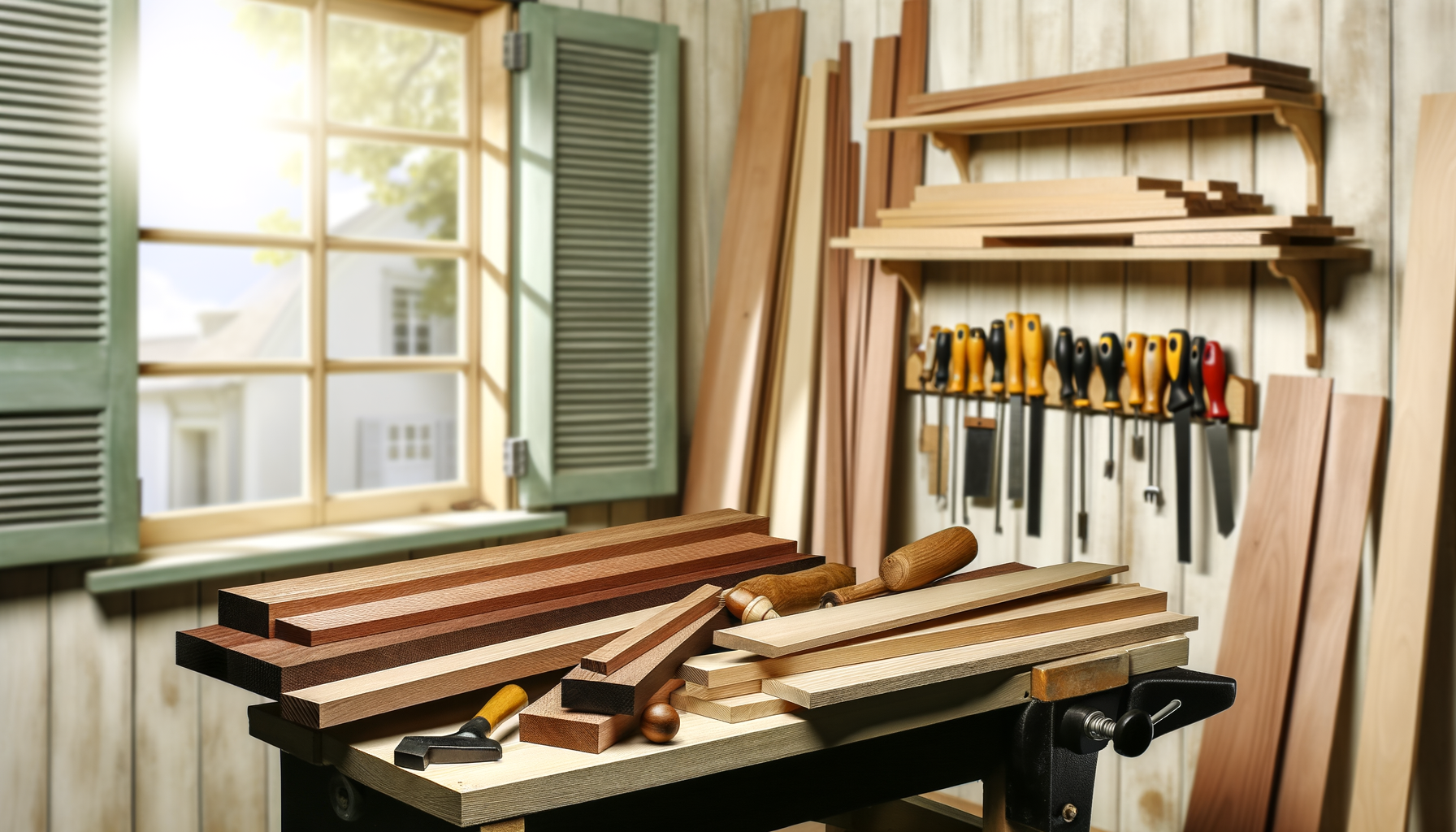Introduction to Woodworking and Wood Selection
The Joy of Woodworking
Woodworking is an art form that connects us to the natural world and our heritage of craftsmanship. The joy of woodworking lies in the transformation of a raw, organic material into functional and beautiful objects. Whether it’s a bespoke piece of furniture, a handcrafted toy, or a custom cabinetry, the act of shaping wood with one’s hands provides a sense of accomplishment and creative fulfillment. The tactile experience of wood, with its unique textures and aromas, adds to the allure, making woodworking not just a hobby or profession, but a passion for many.
Understanding the Importance of Wood Selection
Selecting the right wood is crucial to the success of any woodworking project. The choice of wood can affect the strength, durability, aesthetics, and workability of the finished piece. Understanding the properties of different wood types, such as grain patterns, hardness, and moisture content, is essential for making informed decisions. Moreover, the right wood selection can enhance the beauty of the final product, ensuring that it stands the test of time both functionally and visually.
Factors Influencing Wood Choice
Several factors come into play when choosing wood for a project:
- Project Type: The intended use of the finished item dictates the required strength and durability of the wood.
- Aesthetics: The color, grain, and texture of the wood should complement the design and style of the project.
- Workability: Some woods are easier to cut, shape, and finish than others, affecting the ease of the project.
- Availability: Local availability and sustainability of wood species can influence choice and cost.
- Cost: Budget constraints may require a balance between quality and affordability.
- Environmental Impact: Eco-conscious woodworkers often prefer woods sourced from sustainable forests or reclaimed materials.
By considering these factors, woodworkers can select the most appropriate wood for their projects, ensuring both beauty and functionality.
Wood Types and Their Characteristics
Softwoods: Properties and Best Uses
Softwoods, derived from gymnosperm trees like pines and cedars, are known for their rapid growth and lighter weight. These woods typically have a straight grain and are less dense than hardwoods, making them easier to cut and shape. Common softwoods include:
- Pine: Known for its affordability and versatility, pine is widely used in construction, furniture making, and paper production.
- Spruce: Valued for its strength and stiffness, spruce is often used in construction and for making musical instruments.
- Fir: With its resistance to decay, fir is commonly used in construction lumber and plywood.
- Cedar: Cedar stands out for its natural resistance to rot and insects, making it ideal for outdoor applications like siding and decking.
- Hemlock: Hemlock’s fine texture and straight grain make it suitable for construction lumber and paper production.
Softwoods are best used for structural framing, interior moldings, window frames, and certain types of furniture, particularly when cost-effectiveness and ease of use are priorities.
Hardwoods: Properties and Best Uses
Hardwoods come from angiosperm trees, which are typically slower growing and yield denser wood. This category includes woods like oak and maple, which are renowned for their durability and complex grain patterns. Popular hardwoods include:
- Oak: Oak is a durable wood with a distinctive grain, making it a favorite for furniture and flooring.
- Maple: Maple’s light color and resistance to wear make it ideal for high-traffic areas like floors and kitchen cabinets.
- Cherry: Cherry wood’s rich color and grain are prized in furniture making and cabinetry.
- Walnut: Known for its dark color and fine texture, walnut is durable and resistant to decay, suitable for outdoor furniture.
- Mahogany: Mahogany has a straight, fine grain and is a top choice for high-end furniture and detailed woodworking.
Hardwoods are commonly used for furniture, flooring, cabinetry, and decorative woodworking, where their beauty and longevity are highly valued.
Exotic Woods: When to Use Them
Exotic woods, such as ebony or teak, are often imported from tropical regions and can offer unique colors, grain patterns, and durability. These woods are typically more expensive and may be subject to import regulations. Exotic woods are best used in projects where their distinctive appearance will stand out, such as in fine furniture, inlay work, or specialty items. However, it’s important to consider the environmental impact of using exotic woods and to ensure they are sourced sustainably.
Sustainability and Wood Sources
When selecting wood for your projects, sustainability should be a key consideration. Look for woods that are certified by organizations like the Forest Stewardship Council (FSC), which ensures they come from responsibly managed forests. Additionally, consider the carbon footprint of transporting the wood to your location. Local or regional woods can reduce transportation emissions and support local economies. By choosing sustainable wood sources, you not only contribute to the health of the planet but also ensure the availability of wood for future woodworking enthusiasts.
Grain Patterns and Wood Aesthetics
Understanding Grain Patterns
The grain of wood refers to the direction, texture, and appearance of the wood fibers. Grain patterns are a result of the wood’s growth process and are unique to each piece, much like a fingerprint. There are two primary types of grain patterns: straight grain, where fibers run parallel to each other, and figured grain, which includes patterns like birdseye, burl, and flame. Understanding these patterns is crucial for woodworkers, as they affect not only the aesthetics but also the workability and stability of the wood.
Selecting Wood for Visual Appeal
When selecting wood for a project, visual appeal is often a top consideration. The wood’s color, grain, and texture contribute to the final look of the piece. For a harmonious appearance, choose wood with a grain pattern that complements the project’s design. For example, a straight grain might be ideal for a sleek, modern piece, while a figured grain can add dramatic flair to a more artistic or decorative item. Additionally, the finish applied to the wood can enhance or mute the natural grain, so consider the desired outcome when planning your project.
Matching Wood to Project Style
The style of your project should influence the type of wood you select. Traditional styles may call for classic hardwoods like oak or cherry with rich, warm tones and prominent grain patterns. Contemporary designs might benefit from woods with subtler grains, such as maple or birch. For rustic projects, woods like pine or cedar can provide a more natural, knotty appearance. Always consider the wood’s characteristics and how they will align with the project’s intended style and use.
Ultimately, the choice of wood will significantly impact the aesthetic and functionality of your finished project. By understanding and selecting the appropriate grain patterns, and matching the wood to the project style, you can create pieces that are both beautiful and suited to their intended purpose.
Woodworking Project Planning
Assessing Wood Strength and Durability Needs
When embarking on a woodworking project, it’s crucial to consider the strength and durability required for the intended use of the final product. Furniture that will bear significant weight, such as bookshelves or benches, demands sturdy hardwoods like oak or maple. For decorative items that will not endure heavy use, softer woods like pine may suffice. Evaluate the load-bearing requirements and longevity expectations to ensure your selection aligns with the project’s demands.
Considering Wood Movement
Wood is a living material that expands and contracts with changes in humidity and temperature. This phenomenon, known as wood movement, must be factored into the design to prevent warping, cracking, or splitting. For instance, when constructing a tabletop, allow for the expansion by using proper joinery techniques that accommodate movement. Understanding the direction of the grain and how different species react to environmental changes is essential for the longevity of your project.
Budgeting for Your Wood Purchase
Wood can be one of the most significant expenses in woodworking. Begin by calculating the amount of wood needed, considering both the quantity and dimensions of the lumber. Prices vary widely based on wood type, quality, and whether it’s domestic or exotic. Set a realistic budget that reflects both the material costs and the value of the finished piece. Don’t forget to account for potential waste due to cuts and errors. Opting for local and sustainable wood sources can also be cost-effective and environmentally friendly.
Sketching and Prototyping
Before cutting into your wood, it’s wise to sketch your design or create a prototype. This can be done using free woodworking design software like SketchUp, which allows for detailed 3D modeling and generates a cut list. A prototype, even if made from cheaper materials, can help identify potential design flaws and save time and resources in the long run. Visualizing the final product through sketches or models ensures that all components fit together as intended and can guide you through the construction process.
Planning is a pivotal stage in woodworking that sets the foundation for a successful project. By carefully assessing the wood’s strength and durability, considering wood movement, setting a budget, and sketching or prototyping your design, you can approach your project with confidence and precision.
Working with Wood: Tips and Techniques
Cutting and Shaping Wood
Every woodworking project begins with cutting and shaping wood to the desired form. The key to success lies in precision and understanding the nature of the wood you’re working with. Start by selecting the right saw for the job—whether it’s a handsaw for fine control or a power saw for efficiency. Always mark your cuts clearly and measure twice before cutting. When shaping wood, use sharp chisels and planes to avoid tear-out and achieve a smooth surface. Remember, the goal is to minimize the amount of sanding required later on.
Joinery Techniques for Different Woods
Joinery is the cornerstone of woodworking, and different woods require different joinery techniques. Softwoods, being less dense, are more forgiving and can be joined using screws or nails in addition to traditional wood joints. Hardwoods, on the other hand, demand precise joints that fit snugly without gaps. Techniques such as dovetailing, mortise-and-tenon, and biscuit joinery are ideal for hardwoods. Always consider the wood’s grain direction and movement when planning joints to ensure long-lasting furniture.
Finishing Techniques to Enhance Wood Beauty
Finishing is both an art and a science, transforming the raw wood into a beautiful and durable piece. Begin with a thorough sanding, progressing from coarser to finer grits until the wood is smooth to the touch. Apply stains if desired, keeping in mind that they can accentuate the wood’s natural grain. Choose a finish that complements the wood and the piece’s intended use—oil finishes for a natural look, lacquer or polyurethane for durability. Apply finishes in a dust-free environment and allow ample drying time between coats. For an exceptional sheen, consider hand-rubbing the final coat with fine steel wool or a polishing compound.
Maintaining Tools for Optimal Woodworking
Sharp, well-maintained tools are essential for quality woodworking. Dull blades can cause inaccuracies and may even be dangerous. Regularly clean and sharpen your cutting tools, and store them properly to prevent rust and damage. For power tools, check for alignment and make necessary adjustments. Replace parts like belts and brushes as needed to keep the tools running smoothly. Remember, taking care of your tools not only ensures the best results but also extends the life of your equipment.
By following these tips and techniques, you’ll be well on your way to creating woodworking projects that are not only structurally sound but also aesthetically pleasing. Whether you’re a seasoned woodworker or a beginner, always strive to learn and improve your craft.
Troubleshooting Common Wood Issues
Dealing with Wood Defects
Wood defects can range from knots and cracks to insect damage and discoloration. Identifying these issues early is key to ensuring a high-quality finish. For knots, you can either incorporate them as a feature of your design or cut around them. Cracks can often be filled with wood filler or stabilized with epoxy resin for a smooth finish. Insect damage should be treated with appropriate chemicals to prevent further deterioration, and discolored wood can sometimes be salvaged by sanding or using a wood bleach. Always inspect wood thoroughly before purchase and again before starting your project.
Preventing and Fixing Wood Warping
Warping is a common issue caused by uneven drying or moisture absorption. To prevent warping, store lumber in a controlled environment and allow it to acclimate to your workshop’s humidity before use. If you encounter warping, you can sometimes correct mild cases by re-wetting the wood and clamping it flat until dry. For more severe warping, a jointer or planer may be necessary to remove the warped areas, though this will reduce the thickness of your wood. Always ensure your wood has a consistent moisture content before beginning your project.
Addressing Moisture Content Concerns
Moisture content in wood can lead to warping, swelling, or shrinking as it adjusts to the environment. Use a moisture meter to check the wood’s moisture level before starting your project. Ideal moisture content varies, but generally, indoor projects should have wood at 6-8% moisture content, while outdoor projects can tolerate slightly higher levels. If the wood is too wet, allow it to dry in a controlled environment. If too dry, introduce moisture slowly to prevent cracking. Properly acclimating your wood to the working environment is crucial for the longevity and stability of your project.
Showcasing Your Wood Projects
Photographing Your Work
After pouring your heart and skill into a woodworking project, capturing its essence through photography is the next step. Good photographs do more than just document your work; they tell a story and showcase the craftsmanship and detail that went into each piece. To photograph your work effectively, consider the following tips:
- Lighting: Use natural light when possible, as it brings out the true color and texture of the wood. Avoid harsh shadows and highlights that can obscure details.
- Background: Choose a neutral or non-distracting background that complements the wood without competing for attention.
- Angles: Take multiple shots from different angles to highlight unique features or the overall structure of the piece.
- Details: Include close-up shots to capture the intricacies of the grain patterns, joinery, or finish.
- Editing: Use photo editing software sparingly to adjust the exposure, contrast, and color balance to reflect the piece’s true appearance.
Sharing Projects with the Woodworking Community
Sharing your work with the woodworking community can be both rewarding and educational. Platforms like Instagram, Pinterest, and dedicated woodworking forums are excellent places to start. When sharing:
- Be Descriptive: Include information about the type of wood, techniques used, and any challenges you overcame. This helps others learn from your experience.
- Engage: Respond to comments and questions. Engagement can lead to meaningful exchanges of ideas and techniques.
- Hashtags: Use relevant hashtags to reach a wider audience who share your interest in woodworking.
- Collaborate: Don’t shy away from collaborations with other woodworkers, as this can lead to new insights and opportunities.
Receiving and Implementing Feedback
Feedback is a crucial part of growth in any craft. When you receive feedback:
- Stay Open-Minded: Constructive criticism can be invaluable for improving your skills. Listen carefully and consider the perspective being offered.
- Ask Questions: If feedback is vague, ask for specifics that can help you understand how to improve.
- Reflect: Take time to reflect on the feedback and decide how it aligns with your goals and style.
- Implement: Apply the feedback to your future projects where appropriate. Remember, not all advice will suit your vision or technique, and that’s okay.
Ultimately, showcasing your wood projects is about celebrating your work, sharing your passion with others, and continuing to grow as a woodworker. Whether through stunning photographs, engaging with an online community, or taking feedback to heart, each step you take is a stride towards mastering the art of woodworking.






